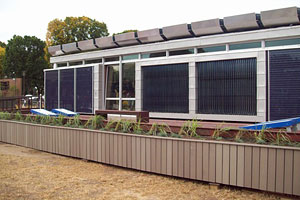 One of 20 solar-powered homes on display at the Mall in Washington D.C. This one is from the University of Kentucky. Credit: Mike MiskellyI was in Silver Spring, Maryland visiting my family last week, and had a chance to visit, with my sister Anne Marie and her boyfriend Mike, the 2009 Solar Decathlon. I’m used to seeing some unusual things on the Mall in Washington, DC—our nations backyard—but was quite impressed by the 20 solar-powered homes arrayed there last Saturday. Students from all over the world designed and built the houses over a two-year period, then disassembled them, transported them to the Mall, and put them back together.
One of 20 solar-powered homes on display at the Mall in Washington D.C. This one is from the University of Kentucky. Credit: Mike MiskellyI was in Silver Spring, Maryland visiting my family last week, and had a chance to visit, with my sister Anne Marie and her boyfriend Mike, the 2009 Solar Decathlon. I’m used to seeing some unusual things on the Mall in Washington, DC—our nations backyard—but was quite impressed by the 20 solar-powered homes arrayed there last Saturday. Students from all over the world designed and built the houses over a two-year period, then disassembled them, transported them to the Mall, and put them back together.
The Solar Decathlon judges these houses in, of course, ten categories.
- Architecture — 100 points
- Market Viability — 100 points
- Engineering — 100 points
- Lighting Design — 75 points
- Communications — 75 points
- Comfort Zone — 100 points
- Hot Water — 100 points
- Appliances — 100 points
- Home Entertainment — 100 points
- Net Metering — 150 points
There are some interesting differences this year, compared to the last contest in 2007. Instead of charging a plug-in hybrid vehicle, as they did in 2007, teams now have to power a home entertainment system. The sponsors of the contest realized that electronic devices, like TVs, make up an ever-bigger share of a typical home’s electricity draw. That’s happening right now, while a plug hybrid car in most every driveway or garage is a thing of the future. A second new feature is that today’s solar houses are connected to the grid. The category “net metering” was not in the last contest. Teams earn points by sending more energy, created by sunlight, to the grid than they use from the grid. The ultimate goal for those of us the home performance field is that all homes become “net-zero” energy homes, or “net-positive,” meaning that the produce as much or more than the grid supplies them over the course of a year. A big problem with solar energy, as well as another renewable source, wind, is that power is created intermittently. Energy storage is necessary, and it is often expensive and not very efficient. With net-zero energy homes, the grid itself provides the storage capacity. When I lived in a Catholic religious community (Holy Cross Priests), the economics of community life were simple—take what you need and give what you can. Same for a net-zero energy house.
I wanted to take a look at the Team Germany (Technische Universität Darmstadt) home, the winners in 2007, but the house was in the process of being judged. Judges don’t announce when they will be visiting a house and which category they will be judging. Teams must keep, for example, the shower water in their solar homes at a precise temperature and flow rate all during the contest. No one knows when a judge will come to the door with a thermometer and flow gauge.
